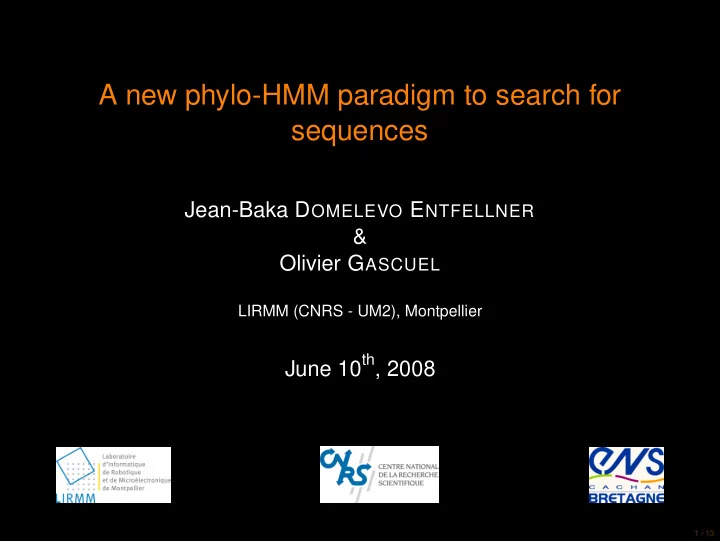

A new phylo-HMM paradigm to search for sequences Jean-Baka D OMELEVO E NTFELLNER & Olivier G ASCUEL LIRMM (CNRS - UM2), Montpellier June 10 th , 2008 1 / 13
What is at stake? Goal Search a databank for sequences homologous to a query protein family. Existing approaches 1 Blast: poor results when identity rate is too low ( � 30%) 2 Profile HMMs: • allow lower percentage of identity between query & target • but make no use of the phylogeny Proposed solution Design a model which takes advantage of: 1 the possible presence in the family of a sequence close to the target 2 the global information (e.g. hydrophilic/phobic columns) conveyed by the alignment 2 / 13
Profile HMMs I 1 I 2 A 0.2 C 0.05 M 2 M 3 D 0.08 E 0.01 .... D 2 Each match and insertion state generates a single a.a. 3 / 13
phylo-HMMs Seminal works: Goldman et al. 1996, Siepel & Haussler 2003 I 1 I 2 ? ? M 2 M 3 ? ? D 2 • each node is populated by a phylogeny which defines a probability distribution over a column of the alignment • typical use: prediction of the conservation or secondary structure of the sites 4 / 13
How we use phylo-HMMs Knowing the phylogeny, we fill in each match state with the distribution of posterior probas of a.a. for the target, given the corresponding column of the alignment. → Felsenstein’s pruning algorithm Arabidopsis thaliana ADRDSKR Anopheles gambiae PERESKR Ciona savignyi PSPVASR Homo sapiens ??????? 5 / 13
Arabidopsis thaliana ADRDSKR Anopheles gambiae PERESKR Ciona savignyi PSPVASR Homo sapiens ??????? I I 2 1 R R P ? S S A ? D E V ? D 2 6 / 13
Arabidopsis thaliana ADRDSKR Anopheles gambiae PERESKR Ciona savignyi PSPVASR Homo sapiens ??????? I I 2 1 .... .... A 0.6 N 0.02 D 0.2 C 0.01 P 0.6 E 0.2 .... .... Q 0.02 S 0.3 V 0.5 R 0.2 .... .... .... D 2 7 / 13
Experimenting • test data: 690 protein families from the Treefam database (Vertebrates + Insects + 1 Tunicate, 4 worms, 2 yeasts and 2 plants). • phylogeny is assumed (calculated with PhyML, matches NCBI consensus). Experimental setup: 1 take those 690 complete families from Treefam 2 gradually prune to remove all Vertebrates, Insects, ... 3 realign the remaining sequences 4 build the profile HMM with hmmbuild 5 phylogenise it to scan for human proteins 6 scan the human proteome with resulting phylo-HMM to find the original protein 8 / 13
9 / 13
Pruned trees (1/3) # of true positives sensitivity standard profile HMM 1345 0.88 Blast 1434 0.94 phylo-HMM 1435 0.94 # expected detections 1526 10 / 13
Pruned trees (2/3) # of true positives sensitivity standard profile HMM 1280 0.86 Blast 1293 0.87 phylo-HMM 1348 0.91 # expected detections 1489 11 / 13
Pruned trees (3/3) # of true positives sensitivity Blast 25 0.38 standard profile HMM 38 0.58 phylo-HMM 52 0.80 # expected detections 65 12 / 13
Conclusion Our model uses phylogenetic information to contextualize a profile HMM. • first results look promising • good combination of Blast and profile HMMs paradigms, robust to remote phylogenetic relations 13 / 13
Recommend
More recommend